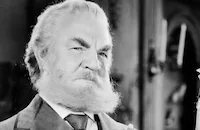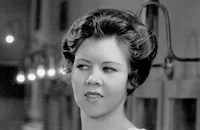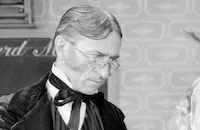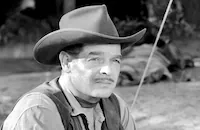Kentucky Moonshine

Brief Synopsis
Cast & Crew
David Butler
Ritz Brothers
Tony Martin
Marjorie Weaver
Slim Summerville
John Carradine
Film Details
Technical Specs

Synopsis
Because ratings for singer Jerry Wade's radio program, which specializes in swing music, have dropped drastically in the past six months, announcer Gus Bryce suggests that they do a hillbilly program. Jerry, who thinks that the previous hillbilly music craze was killed when the public discovered the "hillbillies" were phonies from Brooklyn, offers to go with Gus to dig up "the real McCoy" and calls off an audition for new talent. This disappoints Caroline, a performer from Kentucky, who has been waiting hours to audition. Caroline visits her fellow boardinghouse residents, out-of-work performers The Ritz Brothers, who are faking injuries in a hospital hoping to collect after being in an automobile accident. When they learn that the man who hit them is uninsured and on relief, they return to the boardinghouse. After Caroline tells them about the search for hillbilly talent, the boys decide to go to Kentucky and disguise themselves as hillbillies, so that Jerry will hire them. Caroline gets travel money from "Spats" Swanson, who is trying to seduce her, by telling him that her aunt needs false teeth. In the town of Coma in the Blue Ridge Mountains, the Ritz Brothers and Caroline stay in the delapidated Slack family shack. They are confronted by the Hatfields, who have feuded with the Slacks for nearly eighty years. When Jerry and Gus arrive, the Ritz Brothers, disguised in beards, perform for them, as does Caroline, disguised as the Ritz's sister. Jerry is impressed with them all, and he convinces his sponsors to allow him to broadcast his show from Coma. Caroline grows to like Jerry and feels bad about deceiving him. At the show, when the Ritz Brothers see the drunken Hatfields in the audience, they pretend that they have the hiccups, so Jerry sings instead. In New York, because of a bad connection, almost none of the show is heard. When the brothers see that the Hatfields have fallen asleep, they perform, but Hank Hatfield awakens and sees them. He revives his brothers, who shoot at and chase the Ritz Brothers. Jerry arranges for his sponsor to allow him to bring the show to New York, but Caroline says she will not go. She and Jerry walk by a stream, where he bets a dollar to a kiss that he can hit a log with a stone. After two kisses, Caroline says that she now wants to go to New York, and they embrace. In New York, shortly before the broadcast, Spats comes to Caroline's hotel room and threatens to tell reporters about the ruse unless the Ritz Brothers pay $300. They give him the money, but he then says that he will tell anyway and knocks out two of them before Harry Ritz knocks him out, and then, for no apparent reason, knocks himself out. Gus finds out that the brothers are fakes, but they tie him up in the bathtub. Caroline leaves a note for the brothers saying that she can't hurt Jerry, but that she does not want to spoil their chances, so she is leaving for Chicago. The brothers show Jerry the note and reveal their scheme, and Jerry goes to Grand Central Station in search of Caroline, while the Ritz Brothers take over the show. Their act is a hit, and Jerry finds Caroline, who says she will marry him. Impressed with the Ritz Brothers, the sponsor sees the need for a comedy show. Jerry arrives in time to sing the last number, which he shares with the Ritz Brothers.

Director
David Butler
Cast
Ritz Brothers

Tony Martin

Marjorie Weaver

Slim Summerville

John Carradine
Wally Vernon

Berton Churchill

Eddie Collins

Cecil Cunningham
Paul Stanton

Mary Treen
Francis Ford
Brian Sisters
Clarence Hummel Wilson
Frank Mcglynn Jr.
Jan Duggan
Si Jenks

Irving Bacon

Olin Howland
John Hiestand
Carroll Nye
Tom Hanlon
Ted Lorch
Allen Wood
Charles Tannen
Philippa Hilbere
Ernest Wood
Freddie Walburn
Arthur Aylsworth
Paddy O'flynn
Lester Dorr
Wally Maher

Robert Lowery
Sherry Hall
Dick French
Jack Gargan
Milton Kibbee
Clarice Sherry
June Wilkins
Kay Griffith
Lucille Miller
Gloria Brewster
Iva Stewart
Joan Castle
Claude Allister
Joe Twerp
John "skins" Miller
Forbes Murray
Jack Norton
Guy Wilkerson
Crew
Art Arthur
Irene Beshon
Harry Brand
Alfred Bruzlin
George Carpenter
J. F. Casey
Lewis Creber
D. L. Daniels
Doris Drought
Ed Ebele
Herbert Farjeon
Walter Ferris
W. F. Fitzgerald
William Fremdling
Ray Golden
Ray Golden
E. Goncz
James Gruen
Robert Guggenheim
Roger Heman
Bernard Herzbrun
H. R. Hobson
Leo Houck
James Jensen
Ralph Jester
Lou Johnson
Eddie Jones
Curtis Kenyon
Andy Kisch
Sid Kuller
Sid Kuller
Jack Lait Jr.
Ruggiero Leoncavallo
Thomas Little
Kenneth Macgowan
Ferdinand Meine
Jack Miller
Sidney D. Mitchell
Eleanor Morra
Irene Morra
M. M. Musselman
M. M. Musselman
Ray Nolan
Josephine Perrin
Robert Planck
Lew Pollack
Herb Romey
Royer
Ad Schaumer
Louis Silvers
Jule Styne
Lee Vallee
J. Van Wormer
Don Wakeling
Harry Webb
Darryl F. Zanuck

Film Details
Technical Specs

Articles
Kentucky Moonshine
Caroline (Marjorie Weaver), a singer from Kentucky who has been waiting to audition, learns about the plan and tells her friends, the out-of-work Ritz Brothers. The four decide to go to Coma, KY, and pretend to be authentic hillbillies in order to get the job. In Coma, they live in a shack, where they learn that their landlords are involved in a feud with the Hatfields (John Carradine, Francis Ford, Mary Treen and Slim Summerville), who become their enemies. Jerry and Gus arrive in Coma and see Caroline and the Brothers, now disguised as hillbillies, perform. They win the audition and go back to New York to perform on Jerry's show. But things go awry when Spats Swanson (Eddie Collins) blackmails Caroline and the Brothers for $300 because he knows their true identity.
Directed by David Butler and written by M.M. Musselman and Art Arthur, from an original story by Musselman and Jack Lait, Jr., Kentucky Moonshine went into production January 17 through March 26, 1938, under the working title of Moonshine Over Kentucky . The origins of the story came into dispute when Ned Washington, Howard J. Greene and Sam B. Stept sued Fox for a million dollars in a plagiarism claim that the studio had actually based the film on their unproduced script, Nitwit's Holiday. The studio's defense, according to the Fox legal files, were documents showing that in 1937, Fox studio chief Darryl F. Zanuck had requested that producer Kenneth Macgowan create a hillbilly story for Fox contract players Jack Haley, Joan Davis and Wally Vernon. Art Arthur (whose name appears on the final script) and Curtis Kenyon were given the job. Arthur had based his ideas on a real-life visit to a nightclub in New York a few years previously to see a hillbilly act, only to have the club's owner later tell him that the supposed hillbillies were really from Brooklyn. In addition, writer Ralph Spence had written and directed a two-reel short about a Broadway radio station that broadcast "Broadway Hillbillies." Dialect comedian El Brendel, the star of that short, shared the script with director David Butler shortly before Kentucky Moonshine went into production. The lawsuit was later settled for $300.
Kentucky Moonshine was shot in black and white but, according to the American Film Institute, reels three and four were tinted in post-production in sepia and blue. This technique had been used since the earliest days of motion pictures when film stock was dyed various shades to represent day or night. While full-color motion picture film did exist in 1938, three-strip Technicolor was still relatively new and very expensive, so Fox could not have been expected to use Technicolor for a comedy.
The film received good reviews when it was released on May 20, 1938. Motion Picture Reviews noted that "Moviegoers who enjoy the exuberant clowning of the Ritz Brothers will find bits of hilarious entertainment in this picture. [...] Like most pictures starring specialized entertainment, this one has its dull moments and seems too long for what it has to offer, but it reserves its cleverest sequence for the end, and the audience comes away laughing."
By Lorraine LoBianco
SOURCES:
https://catalog.afi.com/
The Internet Movie Database
"Kentucky Moonshine" The Motion Picture Herald June 1938

Kentucky Moonshine
Quotes
Trivia
Notes
Reels three and four of the print viewed were tinted in sepia and blue. The working title of this film was Moonshine over Kentucky. The genesis of the story is discussed and disputed in the Twentieth Century-Fox Records of the Legal Department at the UCLA Theater Arts Library in correspondence pertaining to a plagiarism suit by Howard J. Greene, Sam B. Stept and Ned Washington, who claimed that the film was based on their script, "Nitwit's Holiday." According to Twentieth Century-Fox legal counsel George Wasson, in the summer of 1937, studio chief Darryl Zanuck sent a note to producer Kenneth Macgowan requesting that a hillbilly story be written for contract players Joan Davis, Wally Vernon and Jack Haley. Writers Art Arthur and Curtis Kenyon were give the assignment, and Arthur, formerly a columnist for the Brooklyn Eagle, recalled going to a nightclub in New York three or four years earlier, where the proprietor admitted that the so-called "hillbilly" performers were really from Brooklyn. In another piece of correspondence, writer Ralph Spence stated that he directed a two-reel film starring El Brendel, which was written by himself and Joe Traub, about a Broadway radio station that received complaints from listeners because they employed "Broadway hillbillies" to sing; the manager then sent Brendel, the janitor of the station, on a vacation to obtain real hillbillies. According to Spence, prior to the shooting of Kentucky Moonshine, Brendel gave the script of the two-reeler to director David Butler. The legal records state that the suit, which Variety reported to be for upwards of one million dollars, was settled for three hundred dollars.
According to the legal records, William Demarest was originally scheduled to play the role of "Spats." Publicity for the film, states that Louis J. Witte, a small arms expert, was hired by the studio to teach the Ritz Brothers to shoot, and Ben Sutherland, the "studio sharpshooter," picked off objects with real bullets in the scene where the Hatfields shoot at the Ritz Brothers. J. Edward Bromberg is listed as a cast member in Hollywood Reporter production charts, but his participation in the final film is doubtful.















